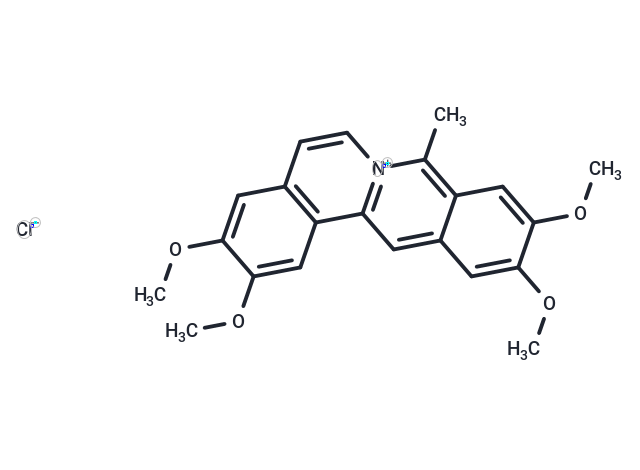Shopping Cart
- Remove All
 Your shopping cart is currently empty
Your shopping cart is currently empty

Coralyne chloride is a protoberberine with strong anticancer activity. It can be used to prepare Coralyne derivatives, a fluorescent DNA-based molecular rectifier built into DNA duplexes through site-specific insertion. It acts as a topoisomerase I toxic molecule, inducing topoisomerase I-mediated DNA cleavage.

| Pack Size | Price | Availability | Quantity |
|---|---|---|---|
| 1 mg | $32 | In Stock | |
| 2 mg | $45 | In Stock | |
| 5 mg | $72 | In Stock | |
| 10 mg | $128 | In Stock | |
| 25 mg | $289 | In Stock | |
| 50 mg | $455 | In Stock | |
| 100 mg | $672 | In Stock |
| Description | Coralyne chloride is a protoberberine with strong anticancer activity. It can be used to prepare Coralyne derivatives, a fluorescent DNA-based molecular rectifier built into DNA duplexes through site-specific insertion. It acts as a topoisomerase I toxic molecule, inducing topoisomerase I-mediated DNA cleavage. |
| In vitro | There is synergism between Coralyne and Paclitaxel on proliferation and migration of breast cancer cell lines. This study also showed that combinational drug treatment decreased the expression of ki-67 and there was an increase in pro apoptotic factor Bax with decreased in expression of anti-apoptotic factor Bcl-2 in breast cancer cell lines with negligible effect on normal breast cell line[2]. |
| Molecular Weight | 399.87 |
| Formula | C22H22ClNO4 |
| Cas No. | 38989-38-7 |
| Smiles | [Cl-].COc1cc2cc[n+]3c(C)c4cc(OC)c(OC)cc4cc3c2cc1OC |
| Relative Density. | no data available |
| Storage | Powder: -20°C for 3 years | In solvent: -80°C for 1 year | Shipping with blue ice. | ||||||||||||||||||||
| Solubility Information | DMSO: 1.5 mg/mL (3.75 mM), Sonication is recommended. H2O: 3 mg/mL (7.5 mM), Sonication is recommended. | ||||||||||||||||||||
Solution Preparation Table | |||||||||||||||||||||
DMSO/H2O
H2O
| |||||||||||||||||||||

Copyright © 2015-2025 TargetMol Chemicals Inc. All Rights Reserved.